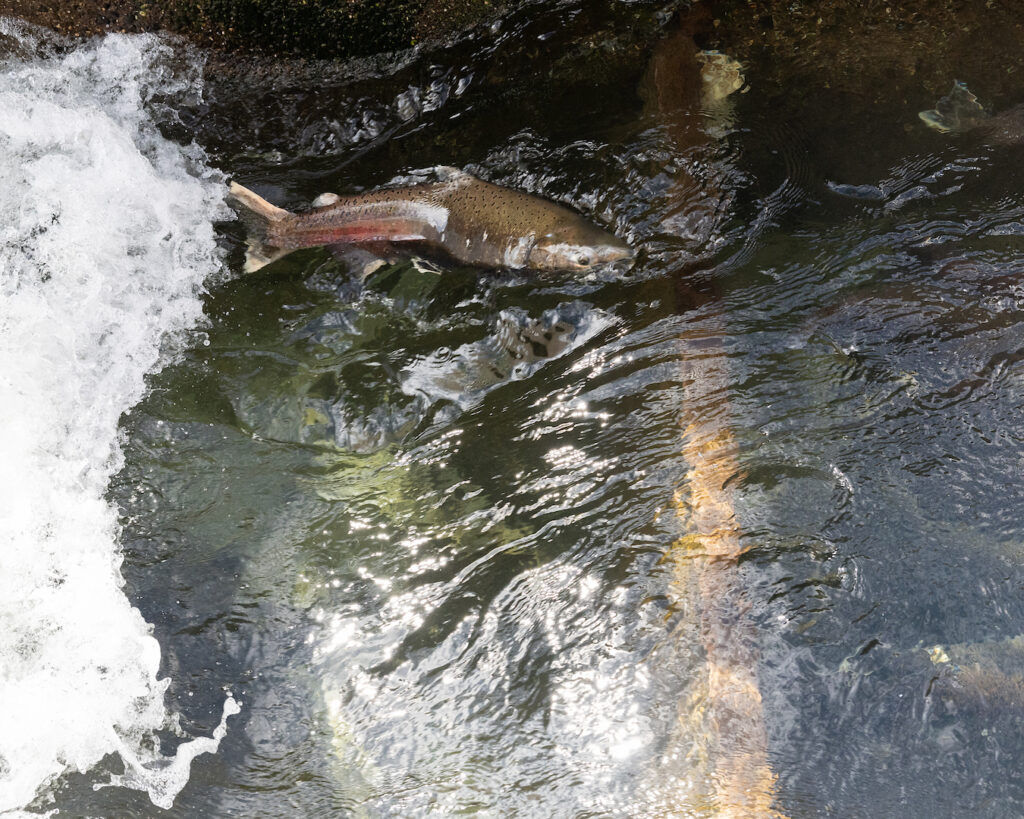
A fall-run Chinook salmon travels up the fish ladder near California Department of Water Resources infrastructure in Oroville. Image: Andrew Nixon and the California Department of Water Resources
A fish ladder is a structure in a natural or artificial waterway that allows fish to pass to a destination, like the ocean or spawning grounds. The ladder can go up, down, or around an obstacle like a dam. Throughout California, the success of native fish species and plants and animals in habitats that relate to them are often tied to whether fish can access and use fish ladders.
“Fish passage is a huge issue throughout the U.S. and the world. It’s probably the biggest concern for hydropower dams, to ensure fish reach destinations like the ocean or their native spawning grounds,” said Steve Amaral, Principal Fisheries Scientist and owner of Biopassage, a consulting firm based in Holden, Massachusetts.
Currently, fish ladders are researched by a wide range of biologists. They are designed and built by a multitude of engineering firms. New information about why and how fish ladders work is continually being discovered.
In order for a fish ladder to be effective, it must be designed well and function adequately as fish pass through it. Conditions for fish passage must also be sufficient. This can include many factors, from the fish being physically fit enough to travel via the fish ladder to the water being cool enough for fish to reach and use the fish ladder. If temperatures rise, due to global warming or local stressors, fish do not always want to make the journey.
“One thing that’s very important is that the entrance needs to be obvious. Fish must be able to figure out how to get in. Universally, we see fish attracted to rushing water, the flow,” said Amaral.
It is a challenge that most of the water in dammed bodies comes through turbines. Less water comes through the fish ladder.
“The first goal is to attract them away from where the bulk of the water is. The next thing you want to do is get them to the top of the fish ladder, if they have to go up. It’s an issue if they’re not fit enough to keep jumping successively up, to reach the final step, or the water is so hot that it causes them stress,” said Steven Cooke, Professor of Biology at Carleton University in Ottawa, Canada.
Cooke has done extensive research on fish. The Cooke Lab at Carleton University currently focuses on sunfish in the Midwest, the Pacific salmonids of British Columbia, and flats and mangrove communities in the Caribbean. Cooke said fish travel in different manners.
“The typical speed varies. How long they can swim at that speed varies, what water temperature they prefer varies, and whether they prefer to swim during daytime or nighttime varies. In most cases, we need to design for multiple species, or multispecies, fish passage,” said Cooke.
This is where biologists and engineers can run into problems.
“We take what we know for salmon and apply that to every other species. We are working to learn from our successes and failures. But every failure means a concern for the population that is negatively affected,” said Cooke.
A hydraulic fish passage system
Fishheart, a Lapland, Finland-based company, has come up with an alternative method to move fish. Their hydraulic system looks like a platform. It can be attached with ropes or steering arms with very strong springs. This system moves fish by attracting them with attractions flows inside the fishway entry unit’s pipeline and then moving them along water. Then the fish do not have to exert as much energy as they would if they were jumping up steps in a ladder.
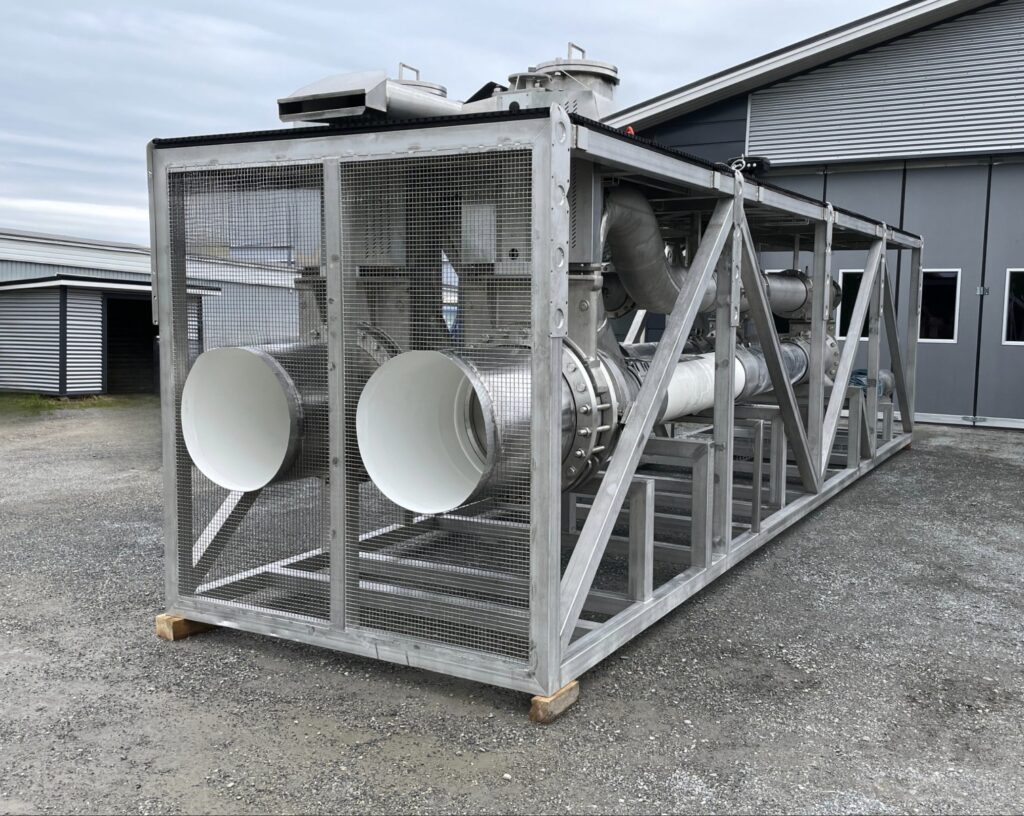
A Fishheart unit outside the company’s old assembly building in Tornio, Finland. Image: Fishheart
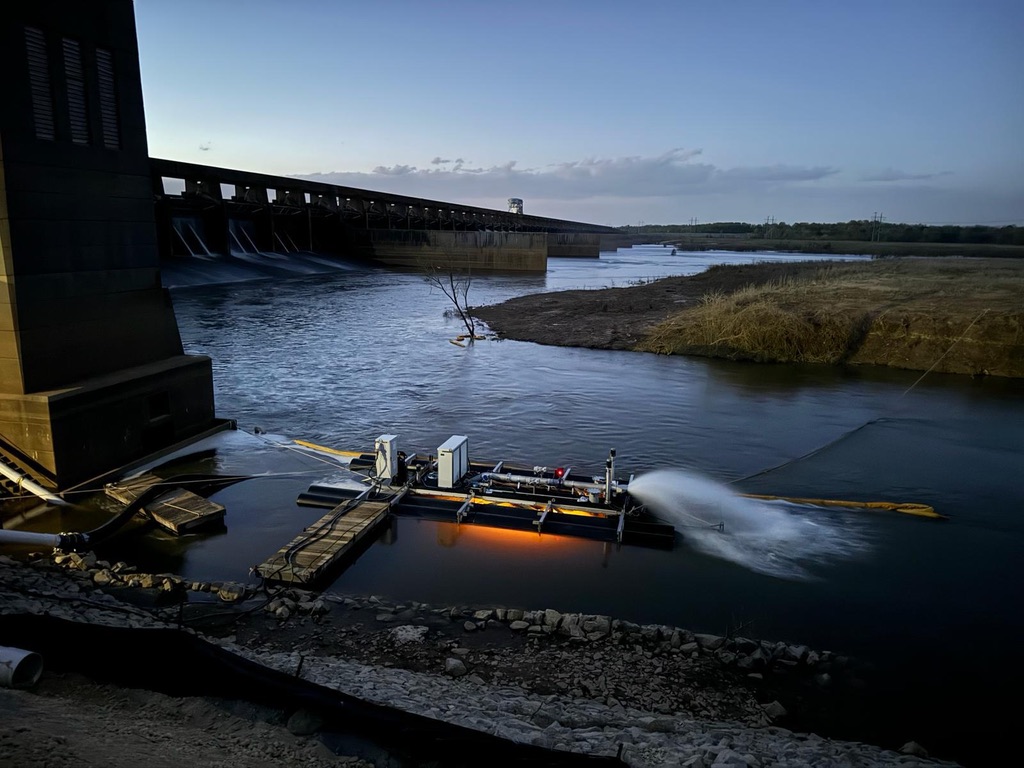
A Fishheart hydraulic fishway system at Santee Dam in the Santee River, South Carolina. The system is owned by Santee Cooper, aka the South Carolina Public Service Authority. Image: Fishheart
“Fishheart was established in 2016 to return fish species to built rivers in Finland and other parts of Europe. Fish populations had died out in certain spots because of blockages with no passage through,” said Mika Sohlberg, Vice President of Sales for Fishheart.
Fishheart’s system consists of a series of guide nets, valves, pumps, actuators, here defined as components that produce force or displacement, a multicamera lighting system, possibly also satellite entry units on both sides of the waterway, underwater cameras, and AI software that identifies fish.
The system attracts fish in through a combination of a “surface attraction flow,” a spray of water on the surface and internal attraction flows. Fish swim into the unit at a “fish-friendly elevation” through the machine out to the other side of the waterway.
The cameras, combined with the AI software, identify all the fish that use the fishway. This helps people monitoring the system figure out how to remove invasive species from the waterway. This is possible by having one pipeline in the system directed into a container.
The AI determines which fish are members of invasive species. Automated step drive them to the container. Operators can then take the fish in the container to be released elsewhere or killed, if needed.
“We build different models of the system for different depths of water and different sizes of rivers. Our system has the capacity to move up to 100,000 fish per day. In Europe, we often use it to move Baltic herring,” said Sohlberg.
The Baltic herring is a relative of the blueback herring, which is commonly found between Nova Scotia down to Florida on the East Coast of the U.S.
Fishheart’s system only needs to be tethered when the spill gates spill out water to the same channel as the turbines. This causes a lot of waves. The tethering helps the machine not bounce as much.
The company developed the concept for a floating hydraulic system because “permanent” fish ladders built into a structure are hard to move.
“Many times, the entity placing the fish ladder doesn’t get it in the right spot. With our system, you can move the fish way entry, until you get it right,” said Sohlberg.
The hydraulic system is built to last between 30 and 40 years. This is typically the point at which a hydrodam owner must renew a license for a structure like a dam.
The benefits of Fishheart’s system include fish being able to swim freely underwater into the pipes, fish not having to expend energy jumping to reach the end of the fish ladder, and the AI software writing a report on the species in the system.
Fishheart currently has systems operational in Finland. It has three systems operational abroad, in Sweden, Australia, and the U.S.
“All the work in the U.S. so far has concentrated on the East Coast. We’re negotiating four to five new projects on the East Coast right now,” said Sohlberg.
Fishheart is always working to advance its AI software and improve its techniques.
“When you go to a new country with new fish species, you start at zero, in terms of learning how to attract the fish. As we track the movement of the fish with sonar, we can adjust the surface attraction flows, guide nets, and positioning of the unit. We gather all the information in Year 1. We analyze it in Year 2 and latest in Year 3 we start to get good results,” said Sohlberg.
The fish ladder at the Parrott-Phelan Diversion Dam
One working example of a fish ladder in California that accomplishes its job can be found at the Parrott-Phelan Diversion Dam (PPDD), aka the Okie Dam, in Butte Creek. The PPDD is located off Honey Run Road in Chico. The PPDD and surrounding property are owned by M&T Ranch and Llano Seco Rancho, two Chico agricultural businesses. Their property borders the Sacramento River. M&T Ranch is responsible for managing the PPDD.
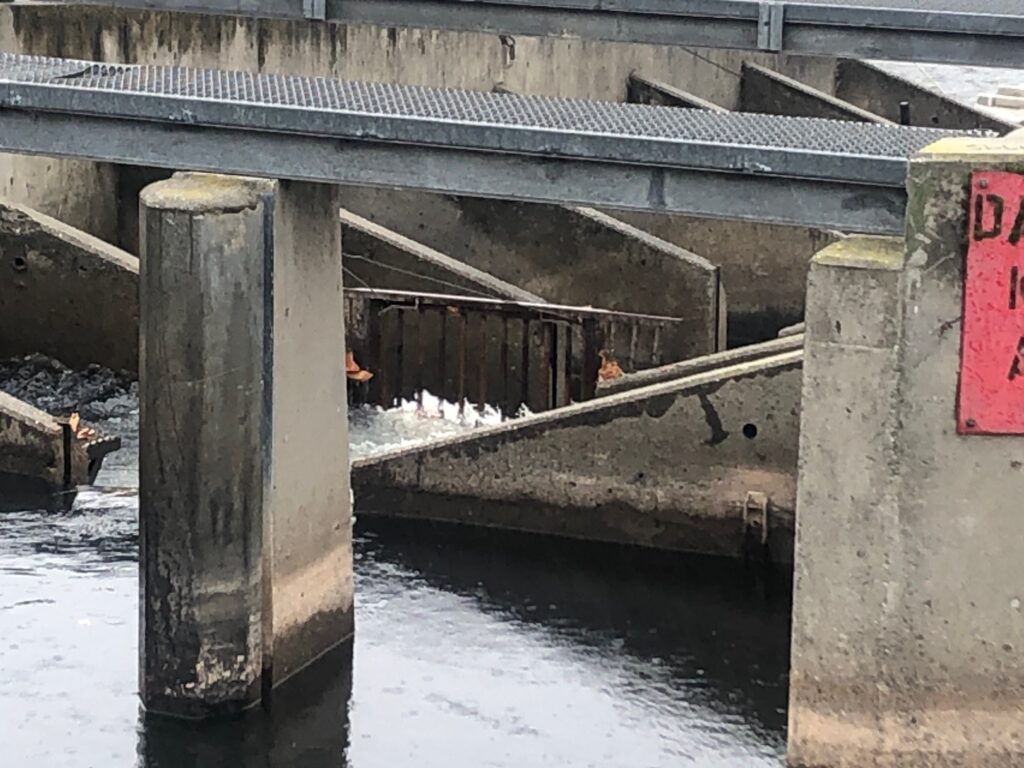
The fish ladder at the Parrott-Phelan Diversion Dam in Butte Creek. Image: Allen Harthorn
The California Department of Fish and Wildlife (CDFW) monitors the fyke trap, a fish trap with a funnel-shaped opening, stationed near the PPDD. CDFW uses the fyke trap to estimate salmon and steelhead trout runs. CDFW also operates a rotary screw trap, a cone suspended between two floating pontoons, located below the fish ladder. These traps help CDFW research and monitor fish.
“We take on responsibility of removing accumulated debris in both of these [the fyke trap and rotary screw trap] to avoid impacting fish during monitoring. There are also orifices at the bottom of each bay of the ladder with gates which we operate and close during the fall to reduce passage of fall-run Chinook up the ladder during spring-run Chinook spawning. This action is to decrease the likelihood of introgression between the two runs,” said Colin Purdy, Environmental Program Manager – Fisheries, for CDFW’s North Central Region.
M&T Ranch removes debris build-up in and around the PPDD, which can affect whether the structure functions.
Adult Chinook salmon travel up the fish ladder February through July. Juvenile Chinook salmon travel down the fish ladder December through May. Other fish also use the fish ladder, including steelhead trout, rainbow trout, Sacramento pikeminnow, hardhead minnow, Sacramento suckers, and Pacific lampreys.
“The fish ladder works for all types of fish. When members of our group go out in the spring, we typically see mainly Chinook salmon. It’s harder to see the smaller fish, the Sacramento suckers, Sacramento pikeminnows, and hardhead minnows,” said Allen Harthorn, Executive Director of Friends of Butte Creek. This organization is a Chico-based community nonprofit dedicated to the health of the waterway.
During the spring, members of the Friends of Butte Creek often pull over on the side of the road and watch the fish come up. The organization has fish-watching days, when one to a few people come out to the PPDD to watch the fish together.
The PPDD fish ladder was completed in 1995. It cost approximately $757,000 when it was constructed. The PPDD fish ladder is of a type called a pool and orifice ladder. It is composed of a linear flow of water, with weirs set at relatively about 6-foot intervals. Each weir has a cut-out near the bottom, creating a passage opportunity. The fish swim through this to traverse the ladder.
“The fish ladder has about six weirs in it. There are “wing walls” on either side and “windows” at the bottom. That way the fish don’t have to go over the weirs. Once they find the windows, they just shoot through,” said Harthorn. The ladder functions well because it provides several opportunities for fish to travel up.
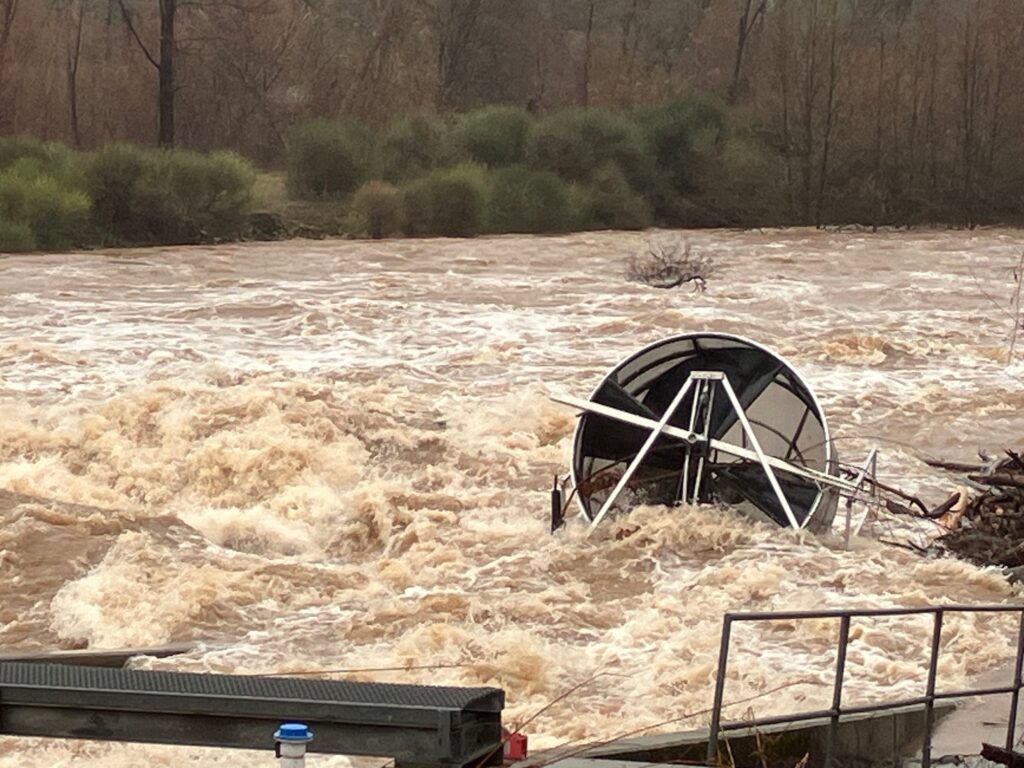
The rotary screw trap at the Parrott-Phelan Diversion Dam during high flows. Image: Allen Harthorn
The problem of the debris build-up around the top and bottom of the fish ladder has been resolved. During heavy flows, the area at the top of the fish ladder and the “windows” at the bottom of the PPDD had gotten partially clogged with woody debris or gravel. The debris swirled and stayed in place due to an eddy that developed around this part of the creek. The logs and other woody debris came from trees that washed down Butte Creek during and after heavy rains.
M&T Ranch solved the problem this September by removing the debris and backfilling the eddy spot with gravel. Now the debris will continue to travel down Butte Creek during high creek flow events. CDFW must still look for and remove debris around the rotary screw trap. This helps the agency monitor outgoing spring run Chinook salmon.
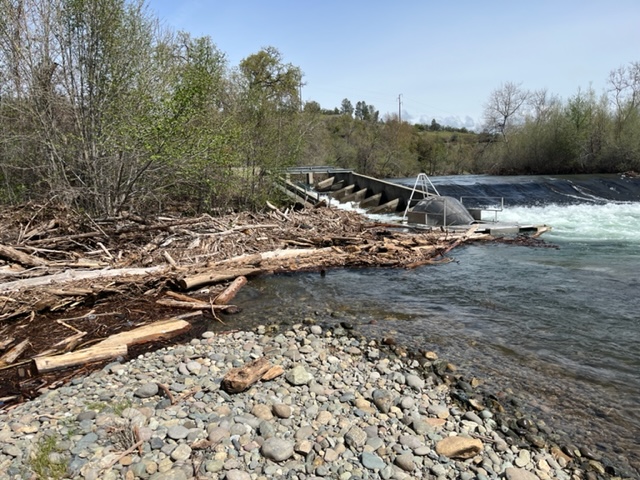
Woody debris caught near the Parrott-Phelan Diversion Dam. Image: Les Heringer
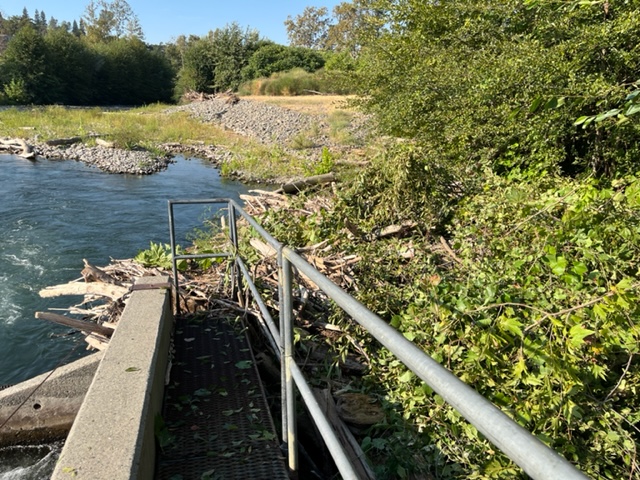
An area near the Parrott-Phelan Diversion Dam before debris removal. Image: Les Heringer
As part of a 1996 agreement with M&T Ranch and Llano Seco Rancho, the PPDD must keep a minimum flow within Butte Creek from October 1 through June 30. Forty cubic feet per second (cfs) must remain in the creek for the fish. The two ranches bypass this 40cfs of Butte Creek import water in exchange for rights to use Sacramento River water through their pumping station on the river. This is the critical late winter to June spring run salmon migration period. The two ranches did this to assist the salmon migrating into and out of Butte Creek. Much of the water diverted from Butte Creek supports wetland habitat.
Recently, Friends of Butte Creek negotiated for and added another 5 cfs to this arrangement. The fish over-summer in deep pools of Butte Creek far above the PPDD fish ladder. Then the fish spawn in fall. The additional water, together with the efforts of other farmers, ranchers, and agencies, helps increase the number of Butte Creek spring run salmon.
In 2025, CDFW’s summer adult snorkel survey results led agency staff to estimate there were 5,387 salmon in Butte Creek at the time of the survey. This was not the effective spawning population size. The effective spawning population size is often much smaller than the number of adult salmon observed moving through the ladder from February to June or in the mid summer snorkel survey. The lower numbers are usually due to prespawn mortalities. Members of Friends of Butte Creek saw very few salmon using the ladder.
“That’s because the ladder was working efficiently and flows were high. The fish went up the weirs or over the dam, It was hard to see them. Many of the fish go through the windows deep in the ladder,” said Harthorn.
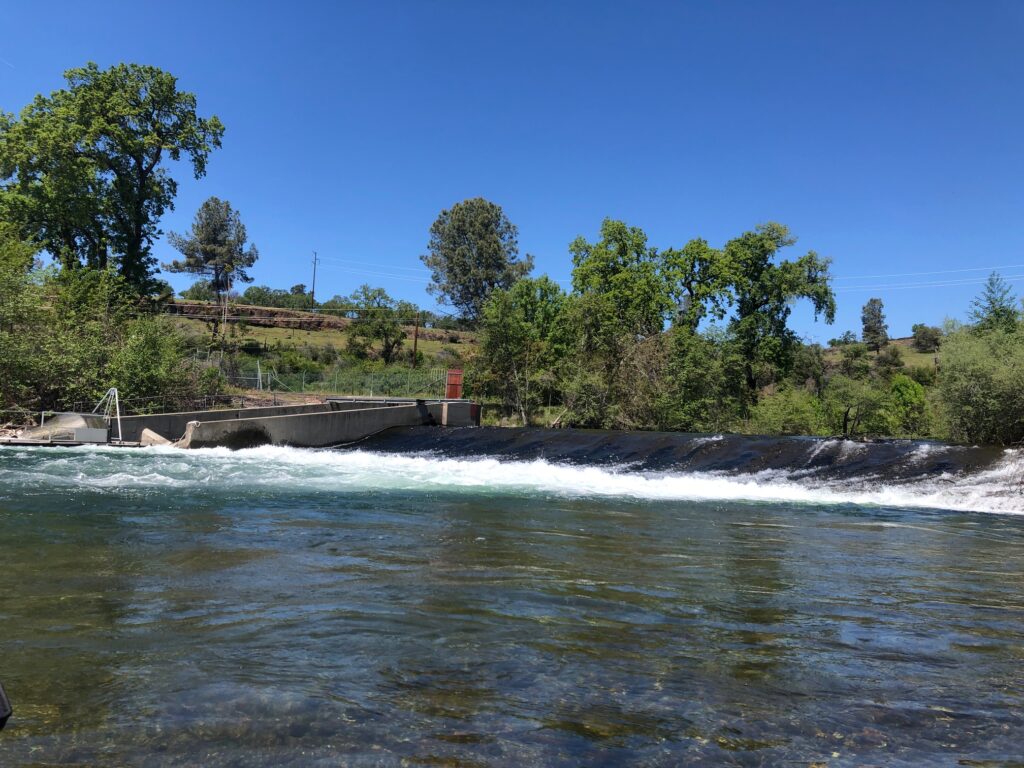
A view of the Parrott-Phelan Diversion Dam from downstream. Image: Allen Harthorn
The PPDD’s fish ladder is an example of a fish passage that is “timely, effective, and safe.”
These are the three markers of success, according to Amaral.
“The fish need to get to where they’re going, on time, and without getting hurt. They need to be healthy after they use the passage,” said Amaral.
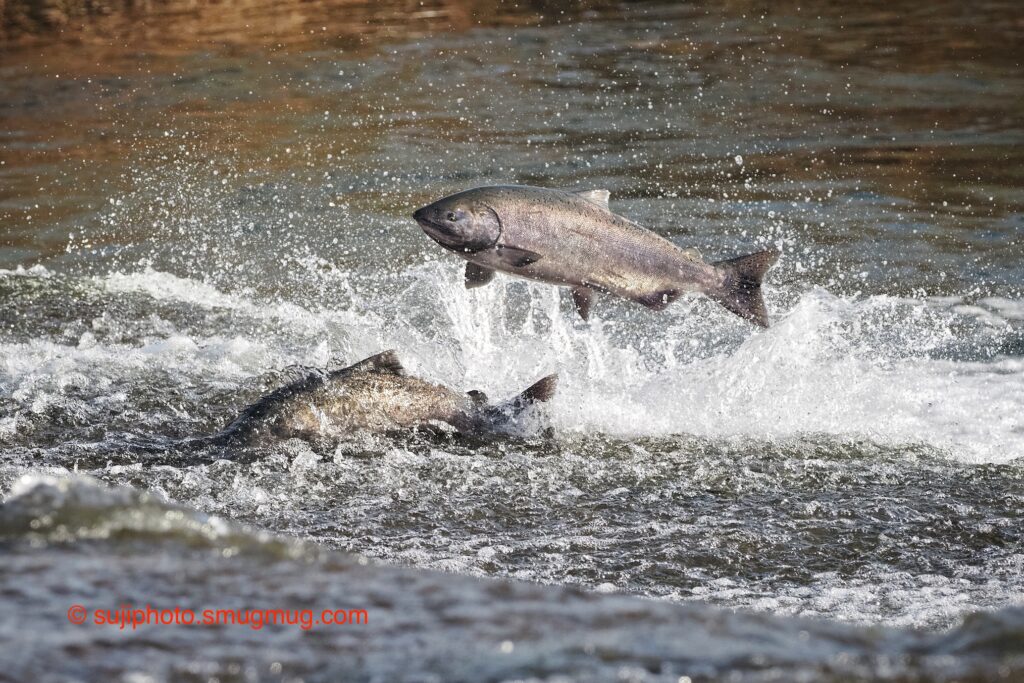
Two Chinook salmon jumping near the PPDD in Butte Creek. Image: Suji Adrian Roland
Cooke added that very few fishways are studied after they are built.
“Methods of observation include going to the top of the fish ladder, to see if the salmon or other fish using it made it up there, and employing telemetry or other tagging techniques, to track the fish,” said Cooke.
One of the most important ways biologists can contribute to improving fish ladders is to set goals for their efficacy.
This explains why volunteer observations like those by Friends of Butte Creek are so helpful.
“You have to listen locally. Gathering local knowledge about how fish behave creates space for involvement. Hearing what happens on the ground, in real time, provides information that researchers and engineers can use to improve fish ladders,” said Cooke.
In areas where indigenous people live, listening to Tribes is key.
Cooke added that nature-based fishways, like a series of pools with rocks that direct fish, usually tend to do a better job than structures made of concrete or steel.
“We’re slowly learning to listen to what people have seen and figure out ways to imitate Mother Nature. That should help us build fishways that are even better than the ones we have now,” said Cooke.
